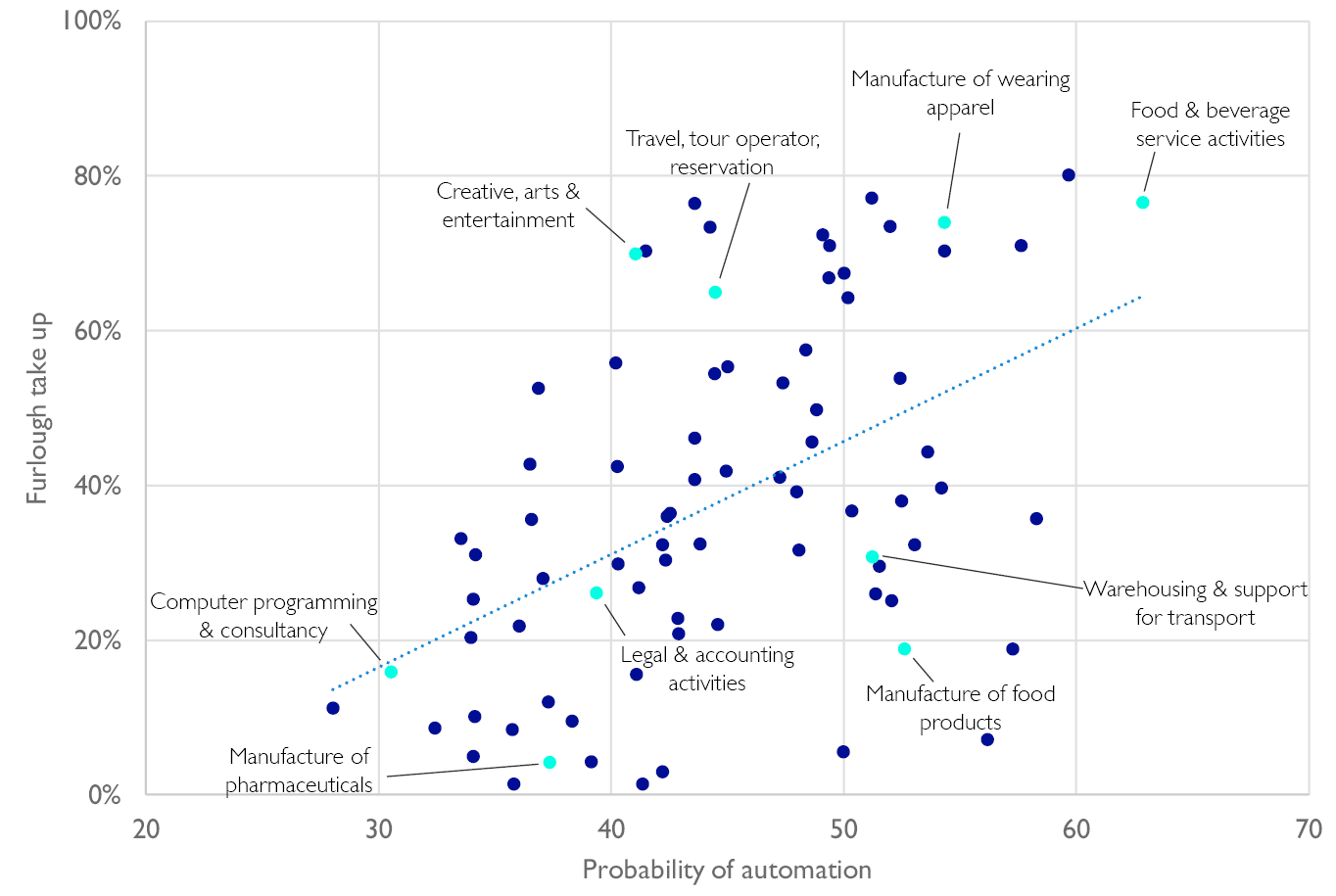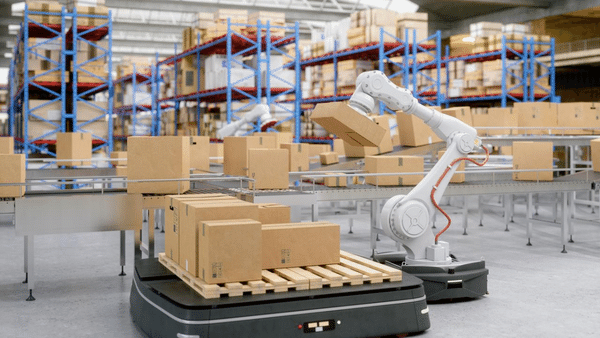Covid-19 not only looks likely to create ‘a tsunami of job losses’ in industries that are unable to turn a profit. Alongside this bleak economic outlook, there are also signs the pandemic could rapidly accelerate the pace of technological change.
Our latest report sets out to explore how these forces could fundamentally reshape the labour market.
To do this, we developed a risk register, which combines an analysis of the impacts of the pandemic on different sectors, with measures of automation risk and their growth or decline over the last decade.
The case for robots in a pandemic: three key arguments
Whether it is robots automating specific tasks, or software changing the labour inputs needed to provide services online via Zoom, there are strong signals that the pandemic will accelerate the pace of technological change and reduce the number of jobs available.
We have identified three compelling arguments from the emerging evidence base:
1. Public health considerations
Businesses could increase automation in order to minimise interaction between workers and consumers and reduce the risk of contagion. For example, there has been a shift towards ‘touchless’ hospitality and retail. Amazon will soon open its first cashierless store in the UK, while mobile robots have been delivering room service to guests in hotels across Hong Kong.
2. Consumer preferences
While new technologies may have initially been introduced for health and safety reasons, some will stick around because they offer consumers more convenient, enjoyable, or affordable experiences. Exercise classes held over Zoom can be delivered cheaply to a much larger number of people, reducing the need for as many fitness instructors, as well as cleaners and other building maintenance staff. The rise of e-commerce and food delivery platforms will create more courier roles but could reduce the number of waiting and shop floor staff.
3. The cost of labour in a pandemic
Social distancing and other protective measures increase the cost of human labour relative to machines that can still work in close proximity, don’t need to self-isolate and don’t require sick pay. This argument is particularly salient in sectors such as manufacturing, where businesses may need to restructure to achieve the same productive capacity with fewer employees.
Of course, so much remains uncertain here. The second wave we are now living through could provide further impetus for automation. But if a vaccine is just around the corner, then the new normal could look surprisingly like the old.
Our hope is that this risk register can help decision makers through these uncertain times by identifying which groups of workers are most vulnerable or resilient to these different forces. And thus, what policy support is needed to make sure all workers can gain or retain access to good work, during the pandemic and beyond.
The risk register
We found that industries with the highest level of furlough take up are considerably more likely to be at risk of automation.
However, this relationship is far from straightforward. Not all industries that have been impacted by the pandemic are at a high risk of automation. Some of the most automatable industries have been shielded from the impacts of the pandemic and may have even benefitted from the Covid-19 economy.
Figure 1: Relationship between furlough take up and automation risk (RSA analysis of HMRC Coronavirus Job Retention Scheme statistics and ONS, the probability of automation in England)

We conducted a segmentation analysis to explore this relationship in more detail. Along the axes of Covid-19 and automation risk, we identify four broad clusters of industries. Our analysis also includes data age, gender, income and education levels, to illustrate how these forces could impact different demographic groups.
- High Covid-19, high automation risk. These industries tend to have high levels of young workers (under 30). Workers are more likely to be men, tend to be lower paid and are less likely to have higher levels of education. 17 percent of employment. Includes industries such as hospitality, sports and recreation and parts of manufacturing and construction.
- High Covid-19, low-medium automation risk. Workers in these industries are more likely to be men, but are relatively well paid and have higher levels of education. 9 percent of employment. Includes industries such as air travel and tourism, creative arts and entertainment, architecture, film production, museums and culture.
- Low-medium Covid-19, high automation risk. These industries are relatively gender balanced, tend to be lower paid and are less likely to have higher levels of education. 17 percent of employment. Includes some key worker industries such as retail, food production, residential care and postal and courier activities.
- Low Covid-19, low automation risk. Overall workers in the most resilient industries are more likely to be women, tend to be well paid and have high levels of education. 35 percent of employment. Includes scientific research, healthcare and education as well as some male dominated industries such as computer programming.
Supporting at-risk workers
Our analysis not only highlights where the pandemic could accelerate the pace of automation, it also underlines how Covid-19 will create new winners and losers. Industries we previously thought to be more resilient are now on the brink of collapse.
Crucially, this analysis allows us to move beyond ‘a one size fits all’ approach to developing policy recommendations. We put forward several recommendations that aim to support these different groups of workers:
- Targeted support for sectors at risk of Covid-19: Introduce a modified version of the government’s Job Support Scheme based on the French two-track system with reduced contributions for the most at-risk sectors. As a condition for long-term support, require that any firm with more than 20 workers introduces a works council.
- Transition services for workers at risk of Covid-19 and automation: Introduce a job security centre alongside job creation schemes to help the most at-risk workers transition into sectors that are more resilient. Provide a transitional basic income to support these workers financially as they retrain.
- Upskilling workers at risk of automation: Introduce personal learning accounts to futureproof roles in sectors at high risk of automation, particularly those that have experienced growth since the pandemic.
Transition services should be targeted towards industries that are at risk of both Covid-19 and automation. Firstly, jobs in industries that are more automatable are less likely to be viable in the long-term, even if they are slightly more viable in the pandemic context. Secondly, these workers tend to be less well paid and therefore transitioning into a new, better paid or more secure role into a growth industry could represent an opportunity to close gaps in good work.
To the extent that the economy may or may not be able to deliver on mass job creation, we see a modified version of the Job Support Scheme as a backstop to prevent rising unemployment. But there is also a case for protecting good jobs in industries that are likely to be viable in the long term, despite being less viable in the short term due to public health restrictions. Certainly, while this much uncertainty abounds about the possibility of mass testing or a vaccine in the next six months, the government should not rule this out.
Related articles
-
Digital lifelong learning in France
Report
Veronica Mrvcic Aoife O'Doherty
Read the findings of our partnership with Bayes Impact, funded by the Mastercard Center for Inclusive Growth, as we supported the design and evaluation of their Jobflix platform.
-
Good Work Guild: inspiring the future of work
Blog
Adanna Shallowe
Learn about the twelve-month journey of The Good Work Guild and the recommendations its global network of Fellows and work practitioners have made.
-
Scaling digital lifelong learning innovations in the UK
Report
Mark Hall Veronica Mrvcic
This report outlines barriers preventing people from accessing UK lifelong learning opportunities and the drivers that could encourage impactful digital innovations.

The Future of Work
We want to make sure that everyone, regardless of background or starting point, can pursue good work.



